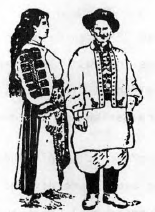Main Body
5. Cleveland at the Height of Immigration
At the turn of the century, when Romanians began arriving in Cleveland, the city had a population of 382,000, eighth largest in the nation. Newcomers were soon caught up in the life of this bustling industrial center. A perusal of the newspapers of the day would include the following items, providing some insight into what the immigrants encountered on their arrival.
In 1900 several streetcar lines were merged into two companies, the Big and Little Consolidated, controlled by Tom L. Johnson and Marcus A. Hanna. Another merger brought them all into the Cleveland Electric Railway. Johnson introduced the three-cent streetcar fare in 1908.
Tom L. Johnson, disciple of Henry George, was elected mayor in 1901. He appointed Newton D. Baker city solicitor and Peter Witt city clerk. During World War I, Baker served as Secretary of State in the Wilson cabinet.
In 1901 Peerless was starting manufacture of its “motorettes” on Quincy Avenue.
Bath houses were built in Gordon and Edgewater parks. Euclid Beach Park was three years old.
Van Dorn Iron Works developed patented locking devices for jail cell doors, recognized as standard in many penal institutions. The lighting division of Westinghouse Electric and Manufacturing Co., located in Cleveland since 1898, began hiring recently arrived Romanian immigrants in its west side plant.
The Standard Drug Company had eight employees when it began operation in a single store and basement.
In 1899 Thompson Products Company was started as Cleveland Cap Screw to manufacture cap screws, bolts, machinery and tools.
In 1902 the Chamber of Commerce recommended purchase of land between E. 9th Street and W. 3rd Street, and between Lake Avenue and Lake Erie for public buildings.
Fred Kohler, police chief appointed by Mayor Johnson was called “the best police chief of the best governed city.”
Natural gas was introduced into Cleveland mains in 1903.
In 1905 President Theodore Roosevelt, Vice President Fairbanks, cabinet members and diplomats attended John Hay’s funeral in Cleveland.
The cornerstone for the new Federal Building was laid on Public Square.
Ash and rubbish collection became city duties in 1906. Glenn L. Martin began designing “aeroplanes” in 1909 and discussion of a new Rapid Transit Line was a live topic in southeastern suburbs.
Dust raised by automobiles swarming in University Circle made paving necessary.
Joseph and Feiss Clothing Manufacturers, organized on a mass production basis, brought scientific methods into management.
In 1911 the original Standard Oil Company was divided into 34 independent companies.
Perfection Stove Company was granted the first 47 patents on kerosene cook stoves.
Ohio State legislature authorized the forming of the Metropolitan Park System.
Movie houses offered Theda Bara, daring Pearl White and Ruth Roland serials, virile William Farnum, rotund Fatty Arbuckle, Mack Sennett and Charlie Chaplin comedies.
In 1900 Cleveland had 32 Roman Catholic churches, divided by nationality backgrounds as follows: 10 Irish, 7 German, 4 Czech, 3 Polish, 2 Slovak, 2 Italian, 1 Lithuanian, 1 Slovene, 1 French and 1 Hungarian. Nearly every parish had its own school.
The Germans had 10 Reformed, 4 United Brethren and 3 Methodist churches. Jewish congregations were divided into backgrounds of: 2 German, 2 Russian, 2 Hungarian, 1 Czech and 1 Polish.
There were 26 Presbyterian and 26 Episcopalian congregations.
The nation was horrified by the Collinwood school fire in which 172 children perished, thereby bringing safety through safer construction and adequate fire inspection to other schools in the country.
The years 1906 and 1907 saw increased expansion in educational and social service facilities. Cleveland School of Art and Western Reserve Historical Society erected new buildings. Cleveland received its second grant from Andrew Carnegie for the Miles Park branch of the Public Library. East Technical High School was built.
In 1908 sparks from “harmless” fireworks in a five and ten cents store set off a counter of fireworks. In the panic, seven were killed and 25 seriously injured. Legislation soon prohibited fireworks in Cleveland.
By 1910, Cleveland’s population had risen to 560,000.

